Please note: a valid prescription is required for all prescription medication.
Glucagon Injection Kit with Diluent for Severe Hypoglycemia
Sitewide Super Sale - Get 15% off when you buy 3 or more of the same product using the code LESS15 at checkout.
Applies to all products originating from Canada. Maximum quantity limited to a 90-day supply per order.
$418.99
You save


This kit contains glucagon powder and a prefilled diluent syringe. It is used to raise blood sugar quickly during a severe low. Here you will find plain instructions, safety details, and practical tips for caregivers.
What Glucagon Is and How It Works
The hormone triggers the liver to release stored glucose. This helps reverse severe hypoglycemia when the person cannot safely swallow. Ordering through CanadianInsulin supports US shipping from Canada with potential savings without insurance. CanadianInsulin.com is a prescription referral platform. We verify prescriptions with your prescriber when required, and licensed Canadian pharmacies dispense your order.
This Use Glucagon Kit guide shows step-by-step mixing and injection basics. Many patients recognize the brand-name option GlucaGen® HypoKit, which contains a vial of powder and a syringe of sterile fluid. In emergencies, a trained helper can use a glucagon emergency kit with diluent to restore blood sugar while medical help is arranged.
Who It’s For
This medicine is indicated for severe hypoglycemia in people with diabetes who use insulin or have a history of significant lows. It may also be used in radiology to relax smooth muscle during certain imaging tests, per labeling.
Do not use it in people with pheochromocytoma or insulinoma, because it can trigger serious reactions. If your clinician prescribes a glucagon for injection 1 mg kit, ensure household members know where it is stored and how to use it. For educational material on symptoms and causes, see our overview of Hypoglycemia.
Dosage and Usage
For severe lows, a caregiver mixes the powder with the provided liquid, then gives an intramuscular or subcutaneous injection as directed on the label. When the person is awake and can swallow safely, give a fast carbohydrate and follow with a snack or meal to replenish glycogen stores. Call for emergency care after administering the dose.
Caregivers should review the steps before travel or activity. Practice with the device instructions to ensure confidence. This product is a glucagon mixing injection kit, so proper reconstitution is essential. When uncertain, defer to the official package insert or your clinician’s guidance.
Strengths and Forms
Common presentations include a kit with one vial of freeze-dried powder and one prefilled diluent syringe. Many kits are supplied at a labeled strength of 1 mg per reconstituted dose. Availability may vary by supplier and manufacturer.
Missed Dose and Timing
This treatment is used for emergencies, not on a schedule. If the first dose is given and there is no improvement, contact emergency services immediately. A second dose may be considered if advised by a clinician or the label, but never delay professional care.
Storage and Travel Basics
Keep the kit at room temperature as directed on the label. Protect from extreme heat, moisture, and light. Do not pre-mix. Check expiration dates regularly and replace the kit before it expires.
When traveling, keep the kit in carry-on luggage and ensure it remains accessible. Pack the prescribing information and a copy of your prescription with the kit. For practical steps on home preparation, see our article on Check Sugar Level. If you need a glucagon injection kit for travel, confirm that companions know where it is kept and how to use it.
Pen Handling and Sharps Disposal
This is a vial and syringe kit, not a pen device. After injection, place the used needle and syringe in a puncture-resistant sharps container. Follow local regulations for disposal, or use a pharmacy take-back program when available. For needle education, see our overview of BD Needles Guide.
Benefits
This treatment can raise blood glucose when oral intake is not safe or possible. It does not require IV access, so trained caregivers can act quickly while awaiting help. The kit is portable and designed for use in home, school, or community settings.
Side Effects and Safety
- Nausea or vomiting, often transient
- Headache or dizziness
- Fast heartbeat or blood pressure changes
- Injection site discomfort
Serious reactions are rare but can include allergic responses or severe blood pressure changes. People with insulinoma or pheochromocytoma may experience dangerous effects. After recovery, low blood sugar can return if you do not eat carbohydrates. If symptoms persist or worsen, seek emergency care.
Drug Interactions and Cautions
Beta blockers can increase heart rate and blood pressure responses. Indomethacin can blunt the glucose-raising effect. Warfarin may show enhanced anticoagulant effect; monitoring is prudent. In malnutrition, adrenal insufficiency, or prolonged fasting, hepatic glycogen may be depleted and response may be reduced. Review your full medication list with your clinician. For more physiology context, see Insulin and Glucose.
What to Expect Over Time
Caregivers should know the signs of severe hypoglycemia and practice the steps periodically. Keep the kit current and stored where it is easy to find. Replace it before expiration, and review instructions after any relocation or routine change. For background on lab monitoring, see Fasting Plasma Glucose.
Compare With Alternatives
Intranasal glucagon offers needle-free administration when training is limited or access is difficult. Consider Baqsimi Nasal Powder when appropriate. For mild lows where the person is awake and can swallow, oral glucose products are often used; see Dextrose options.
Pricing and Access
Our platform lists current options and helps you compare the glucagon injection kit price across suppliers. You can review Canadian pricing with clear US fulfillment. If you have a coupon intent, see active offers on our Promotions page. We provide encrypted checkout for added security.
Orders Ships from Canada to US through licensed pharmacies. For related items, browse Hypoglycemia Aids to prepare a complete response plan.
Availability and Substitutions
Supply can vary. If this kit is unavailable, your prescriber may recommend an alternative presentation or brand. In most regions, a glucagon injection kit prescription required note applies before dispensing. If a substitution is suggested, your provider will ensure it is clinically suitable.
Patient Suitability and Cost-Saving Tips
Good candidates are people at risk of severe lows, including many using insulin or sulfonylureas. Those with tumor-related contraindications should not use this medicine. Ask about multi-month supplies, and set reminders to replace the kit before expiration. Keeping an extra kit at school or work may help reduce risk gaps.
Compare options in Diabetes Supplies to assemble a complete hypoglycemia plan with fast carbs and educational materials. Coordinate training for family and coworkers, and review the steps after any changes to your regimen.
Questions to Ask Your Clinician
- Who should be trained to give my injection?
- What signs should trigger emergency use?
- How soon should I eat after I wake up?
- Which medicines might affect the response?
- What should I do if the first dose fails?
- How often should I replace my kit?
Authoritative Sources
For official labeling and detailed safety information, consult these references:
- FDA-approved labeling for glucagon injection on DailyMed
- Health Canada Drug Product Database entry for glucagon
- Manufacturer product information for branded glucagon kits
Storage and Travel Reminders
Check your kit monthly for integrity and expiry. Keep it accessible at home and during commutes. Review the mixing steps before trips, and carry glucose tablets for mild lows. For causes and prevention strategies, read our overview of Fasting Hypoglycemia.
Ready to order? Place your request with prompt, express, cold-chain shipping with temperature-controlled handling when required. This content is for informational purposes only and is not a substitute for professional medical advice.
Express Shipping - from $25.00
Shipping with this method takes 3-5 days
Prices:
- Dry-Packed Products $25.00
- Cold-Packed Products $35.00
Standard Shipping - $15.00
Shipping with this method takes 5-10 days
Prices:
- Dry-Packed Products $15.00
- Not available for Cold-Packed products
What is included in the glucagon kit?
Each kit typically contains one vial of freeze-dried glucagon powder and one prefilled syringe of sterile diluent, plus instructions for mixing and injection.
Who can administer this medicine?
A trained caregiver, school staff member, or family member can administer it during a severe low when the person cannot safely swallow. Always call for emergency help afterward.
How long does mixed glucagon remain usable?
Use immediately after mixing. Discard any unused solution. Do not store the mixed solution for later use unless the label specifically allows it.
Can it be used for children?
Yes, it may be used in pediatric patients per weight-based labeling and clinician direction. Caregivers should review instructions and practice the steps in advance.
What if the person does not respond?
Call emergency services immediately. If instructed by a clinician or the label, a second dose may be considered while waiting for help.
How should I dispose of used needles and syringes?
Place used components in a puncture-resistant sharps container and follow local regulations or pharmacy take-back programs for disposal.
Does food need to be given after recovery?
Yes. When the person is awake and able to swallow, give fast-acting carbohydrates followed by a snack or meal to prevent a repeat low.
Rewards Program
Earn points on birthdays, product orders, reviews, friend referrals, and more! Enjoy your medication at unparalleled discounts while reaping rewards for every step you take with us.
You can read more about rewards here.
POINT VALUE
How to earn points
- 1Create an account and start earning.
- 2Earn points every time you shop or perform certain actions.
- 3Redeem points for exclusive discounts.
You Might Also Like
Related Articles
Zepbound storage: Keep It Safe With Clear Temperature Rules
This guide explains Zepbound storage so your medication stays effective. You will learn temperature limits, how long doses can stay unrefrigerated, travel practices, and what to do if a pen…
Zepbound and Fatigue: Practical Tips to Ease Tiredness Safely
Feeling drained after starting tirzepatide can be unsettling. Many users describe a mix of low energy, mild aches, and disrupted sleep early on. If you are navigating Zepbound and fatigue,…
Mounjaro Heart Benefits Beyond Weight Loss: Evidence-Based Guide
Interest has grown around Mounjaro heart benefits as clinicians evaluate tirzepatide’s broader impact beyond glucose control and weight. Patients want clear, cautious guidance. This overview explains what current data suggests,…
Ozempic Rebound: A Practical Guide to Prevent Weight Regain
Many people stop GLP-1 therapy and wonder what comes next. Appetite changes, routine shifts, and metabolism can collide. A clear plan helps you keep progress steady and predictable, not reactive.…


